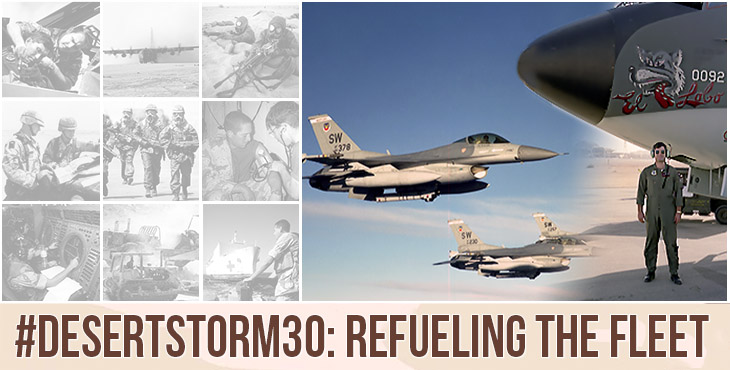In 1990 the newest aircraft in the Air Force’s fleet of KC-135 air refueling tankers was already 25 years old. The venerable airframe based on the Boeing 707 airliner and its crews were being asked to do something few of them had been trained to do – take part in a conventional war.
Long before the air war against Saddam Hussein kicked off Operation Desert Storm, U.S. tanker aircrews trained for a very different mission – deterring Soviet aggression by ensuring nuclear-capable bombers were fully fueled minutes after launch. The conventional war that awaited in the desert was something that would require adaptation.
Defensive procedures
For Air Force Veteran Mark Hasara, the operational differences between Strategic Air Command (SAC) and the tactical air forces in the desert couldn’t have been more stark, but alongside Guard and Reserve pilots, and by “using a lot of math,” he helped create defensive procedures for the KC-135 that are still in use today.
“There were people who felt our procedures would get us killed, but the fighter guys scoffed at those concerns. What’s funny is that now, the tanker community uses similar procedures in its tactics manuals. When Air Mobility Command created the KC-135 Weapons School in 2000, we worked closely with F-15C folks from Oregon to solidify retrograde and defense procedures for the tanker communities.”
The restricted maneuvers they created were not allowed during training, and in 1990 no one had ever flown them, but as the reality of combat dawned, it looked like there would be plenty of opportunity.
Expected losses
Leading up to combat, the Iraqi military was touted as the fourth largest in the world. Its ground forces were replete with modern Soviet equipment and its air forces were the largest in the region, with nearly a thousand combat-capable aircraft including French Mirage F-1s, and several variants of both Soviet MiG and Sukhoi aircraft. In addition, the Iraqis had more than 400 Soviet surface-to-air missile (SAM) systems and thousands of light SAMs. For the KC-135, a large heavy aircraft flying in circles and loaded with 200,000 pounds of fuel, the battlefield looked like a recipe for disaster, and crews were told to expect losses in the range of 10-15 percent for the tanker fleet.
“Just prior to the war starting, Saddam moved a lot of his fighter jets around. A detachment of three MiG-29 Fulcrums moved into Mudaysis Airfield the week before the war started,” Hasara recalled. “Mudaysis was real close to the end of our refueling track the first night… about 75 miles north/northwest of our end air refueling point. So, imagine this… a three-ship of fat tankers loaded with gas all performing retrograde maneuvers on the darkest moonless night for the first time in our careers! But … I had total confidence in the (F-15) Eagle guys sweeping through Iraq and shooting down anything the IRAF got airborne.”
Desert Storm starts
Hasara, as part of the Mission Planning Cell, knew when Desert Storm was gong to start. He saw the message from Lt. Gen. Charles Horner, commander of U.S. and Allied Air Operations about ten days before the Jan. 17 start date.
“Our stick in the ground for starting the war was the meeting between Secretary of State (James) Baker, and (Iraqi Deputy Prime Minister) Tariq Aziz. We knew if that meeting didn’t go well, the war would start pretty soon. I’ll never forget that message.”
After the Baker/Aziz meeting, the second indication of impending war was that Iraq began holding Scud missile practice launches.
“He was getting his forces spun up too,” Hasara said.
Launch order
When the launch order was given, Hasara and his crew did what they were trained to do.
“The first time you ‘see the elephant’ as we say, it was pretty scary,” he admitted. “You just don’t know what to expect. Most of the tanker leadership had flown in Vietnam and many of the Guard folks came from tactical aircraft, so they had much greater confidence in what was going to happen. All us young guys and gals were SAC-trained and didn’t have that experience.”
Once the mission was underway and the tankers were turned north, the cockpit turned quiet.
“All of us were very nervous when the AWAC (Airborne Warning and Control aircraft) started calling out Fulcrums and F-1s airborne in front of us,” Hasara said. “I was very concerned. Once the (tactical aircraft) we were with dropped off and we turned for home, I was elated. We had done good work and were on our way home. By mission five, my heart rate never went up – it was becoming very routine.”
Not a routine mission
Though “routine,” the importance of the tanker missions was never in question. Tactical aircraft were sometimes taking long missions, or leaking fuel from being shot. Tanker crews were responsible for getting more than a few pilots and their aircraft home safely.
“We were in a four-ship of tankers that had to go forty miles inside Iraqi airspace to pick up 32 F-16s that didn’t get refueled pre-strike,” Hasara said. “A first lieutenant who came to our boom had 800 pounds of fuel in his tanks – enough for about six minutes of flight before he flamed out.”
Despite the grim predictions before the war started, no KC-135s were lost during Desert Storm. Since leaving the service, Hasara has written a book about the tanker community during the war called, Tanker Pilot, where he describes working with Guard and Reserve pilots, planning for, and taking part in Operation Desert Storm.
Rosaire Bushey is the public affairs officer for the Salem VA Medical Center. He is an Air Force Veteran.
Graphic artist: Grace Yang
Topics in this story
More Stories
Summer Sports Clinic is a rehabilitative and educational sporting event for eligible Veterans with a range of disabilities.
Report examines the input of over 7,000 women Veterans: They are happier with VA health care than ever before.
Veterans and caregivers, you can help shape the future eligibility requirements for the VA Caregiver Support program.







It is false to state KC-135s are “based on 707 airliners”. In fact KC-135s and 707s are both based on the earlier Boeing 367-80 (aka Dash 80) prototype demonstrator aircraft.
Furthermore, the KC-135 prototype made its first flight over one year earlier than the 707 prototype.
Facts matter.